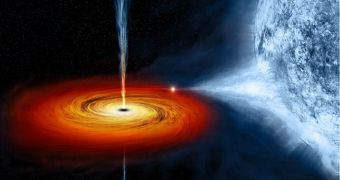More than 30 years ago, based on data available at the time, famed physicist Stephen Hawking proposed that the galaxy Cygnus X-1 had a black hole at its core. Since then, astrophysicists thought they had proved him wrong, but a new study finally demonstrates the contrary.
Not only that, but the team that conducted the investigation – based at the Harvard-Smithsonian Center for Astrophysics (CfA) – also managed to reveal some of the object's ancient history. They showed how it appeared, developed and eventually grew to its current size.
Scientists also have accurate values of the spin and mass of the object, as well as its distance from our planet. As such, Hawking's 30-year-old proposal turns out to be correct after all, astronomers say.
The debate as to the nature of the object visible in Cygnus X-1 has been going on and off for quite some time, but no one on either sides of the argument was able to deliver concrete proof to support their points of view, until now.
The CfA research group used a series of radio, optical and X-ray observatories to augment data collected by the NASA Chandra X-ray Telescope. This approach allowed them to reconstruct the birth and early life of the black hole, which makes Cygnus X-1 one of the few objects for which this was possible.
“This new information gives us strong clues about how the black hole was born, what it weighed and how fast it was spinning. This is exciting because not much is known about the birth of black holes,” says CfA astronomer and study author, Mark Reid.
His research is just one of three scientific papers to be published in the November 10 issue of the Astrophysical Journal, all of them detailing a certain aspect of the black hole. CfA expert Lijun Gou authored the second paper, while the third belongs to San Diego State University's Jerome Orosz.
It would now seem that Cygnus X-1 is in fact a member of a binary system, as it is accompanied by a massive blue star. The rendition to the left shows how the two objects interact, with the dark behemoth accumulating mass constantly from its companion.
“We now know that Cygnus X-1 is one of the most massive stellar black holes in the galaxy. And, it's spinning as fast as any black hole we've ever seen,” Orosz says in his paper. The data the teams had access to allowed them to conduct measurements that were unprecedented in accuracy.
It is now estimated that the massive star from which the black hole was born was in fact about 100 times heavier than the Sun. Experts say that it most likely did not explode in a supernova when it collapsed, but rather did so under the influences of extreme solar winds.
“It is amazing to me that we have a complete description of this asteroid-sized object that is thousands of light-years away. This means astronomers have a more complete understanding of this black hole than any other in our galaxy,” Gou concludes.

 14 DAY TRIAL //
14 DAY TRIAL //